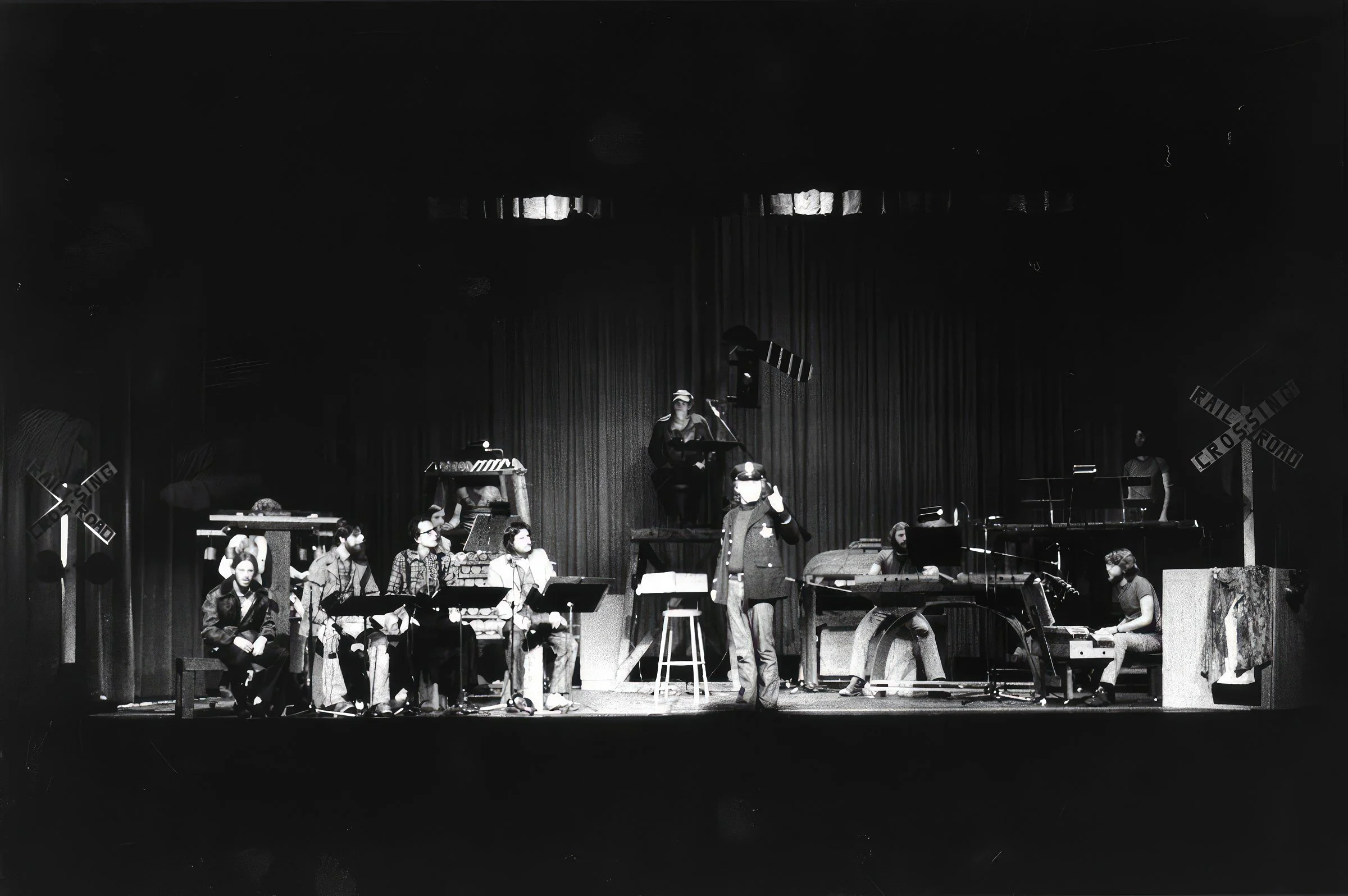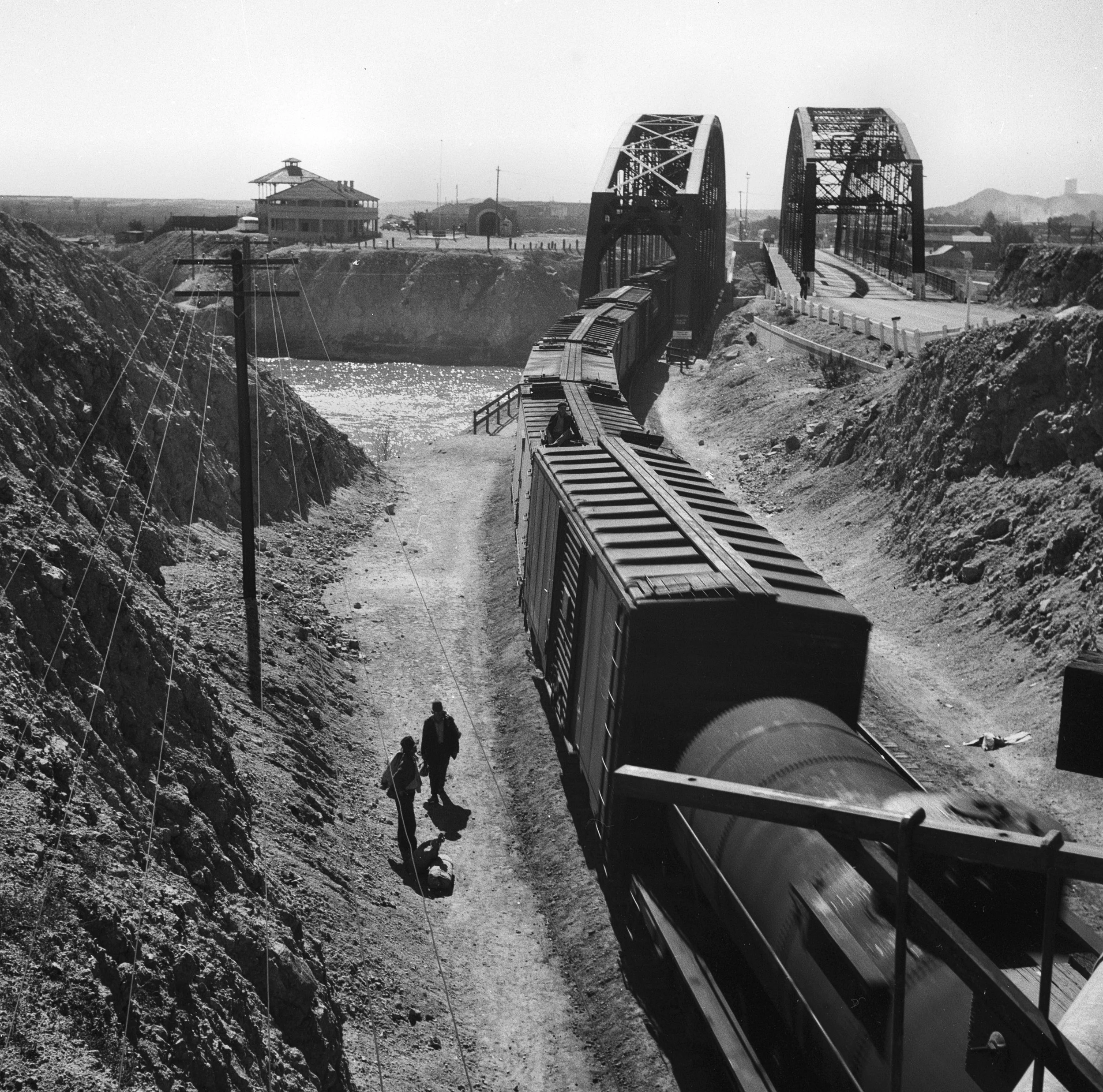The Harry Partch Ensemble at the Los Angeles County Museum of Art, 1976. Front and center is the Chief of Police and music director, Danlee Mitchell. Photographer unknown.
U.S. Highball - Live, 1976
I have wanted to share this recording for years and never found a good way or time to do so. The time presented itself.
When Harry Partch died in 1974, the ensemble that had formed to record and film The Dreamer That Remains was preparing a new production of The Bewitched, under the artistic direction of Danlee Mitchell. Mitchell had taken part in both ill-fated productions of the piece when it was premiered at the University of Illinois, first in 1959. It was Mitchell’s intention to have Partch witness a production that hewed as closely as possible to the composer’s vision, but it came too late.
After performances in San Diego, Los Angeles, and Palo Alto, the ensemble took a short break, followed by a new production of Partch’s U.S. Highball, to be performed in San Diego and… elsewhere. The group ended up doing a short tour that included Los Angeles, San Jose, and Gilroy, CA.
Poster for the 1976 production by ensemble member Dennis Dunn.
Bill Perrine, in his exquisite book “Alien Territory: Radical, Experimental, & Irrelevant Music in 1970s San Diego”, captures well the spirit of that adventure:
“… a production that incorporated the musicians as vocalists and in character roles, more fully embodying Partch’s corporeal concept. As with most of the Partch Ensemble’s activities, the tour was a scrappy endeavor that reflected the group’s collective temperament, which was one of insouciance, self-sufficiency, and unpretentious hustle. Ensemble members were mostly young and, without exception, intensely dedicated, and tours were grueling, low-budget affairs, full of cheap hotels, wobbly U-Hauls, the arduous loading and unloading of Partch’s unwieldy instrument, and little sleep. It was a labor of love performed by a group of friends, with little fanfare and less money.”
The tour kicked off as the featured piece on the Monday Evening Concerts, a storied and long-running series at the Los Angeles County Museum of Art (LACMA). One feature was that they broadcast the concerts (though I can’t remember if it was live on the night of, or a broadcast of a recording that evening). What I have, as a token of remembering this particular group iteration, is a dub of a tape of the broadcast. This is not an audio gem in the traditional sense, but it captures the group that would play together, in various guises over nearly 20 years, still in the bloom of early and youthful zeal. Partch had not been gone from us very long then, and his spirit was still vibrant. Below the player, I offer some of the notes from our album for New World Records, Harry Partch: a Portrait (2015).
Gate 5 Records, Issue No. 6 (1958) - A single 10” 33-1/3 disc.
Few pieces exemplify the work of a composer as well as U.S. Highball does for Harry Partch. The piece is based on a freight-train trip he took in September 1941, traveling from San Francisco to Chicago; he subtitled it "A Musical Account of a Transcontinental Hobo Trip”. During the actual trip, Partch scribbled in a small notebook to record the events, voices, and impressions of the difficulties of the hobo's life. His first version, for three instruments and voices, had been completed in 1943, partly with help from the awarding of a Guggenheim Fellowship. Partch recorded this version in Madison, Wisconsin, in 1946. He later remarked: "Upon studying this recording, I realized a most urgent need - percussion built for this system of music, for these theories. By 1955 I had plenty of percussion instruments and I rewrote the work, putting it in its present form." As performed in Los Angeles, the live recording above is of that final version.
Hobos hopping the rails, Yuma, 1940. This was an image that Partch himself took, and a very similar shot formed the cover of a later LP of the cycle The Wayward (Gate 5 Records, Issue B, 1962)
U.S. Highball falls naturally into three sections, as described by Partch: "The first is a long and jerky passage by drags (slow freights) to Little America, Wyoming. The second is an adagio dishwashing movement at Little America. The third is a rhythmic allegro, mostly by highway (hitchhiking) to Chicago." Throughout the piece, the text is delivered in one of two ways: by the Subjective Voice, who is the protagonist in the true dramatic sense (as well as being the voice of Partch himself); and by several Objective Voices - the instrumentalists, voicing the other hobos on the trip. While the events that served as the source material and catalyst for the work occurred here in the United States, Partch did not view it as "essentially a piece of Americana, a documentary, although if it were only this, I would not minimize it."
Indeed, he viewed it in the larger sense of experience, and as an artistic emanation of that strictly literal expression of life. In his notebook, he had captured the names of stations, hobo inscriptions, and phrases and utterances from the many voices on the trip, only editing out "profanity as repetitive as the sound of wheels on the track." These he set to music, utilizing his instruments to support their speech - never merely as background music - as they would intone them with "the range and speed of the natural speaking voice." Partch always intended a performance of the piece to have the instrumentalists play the parts of the various characters, standing to deliver their lines from their spot on stage, lit. It was very early that Harry Partch had begun to formulate his concept of a truly integrated presentation, intrinsically corporeal. Of this work, he said:
"I have called "U.S. Highball" the most creative piece of work I have ever done, and in the sense that it is less influenced by the forms and attitudes that I had grown up with as a child and experienced in adult life, there can be no doubt of it. The intensity of the experiences preceding it and the intensity of my feelings at the time forced me into a different welter of thought - one that I had to mold in a new way, and for this one work alone."
Partch atop a boxcar. Photographer and date unknown.
Harry gathered experiences and crafted with that material, for the better part of three more decades: viewing life and molding it into artistic expression in a new way. As Arthur Woodbury wrote:
“That Harry Partch is no ordinary person is obvious. If his accomplishments in music had been slight, perhaps it could all end here -- but on the contrary, his accomplishments have been considerable. Anyone who has sat in a room, surrounded by Partch's many instruments, and listened to his music -- this complete and, to many, alien world of sound and drama -- knows what an intimidating experience this can be. The very thought of adopting a philosophical position diametrically opposed to a well-entrenched existing tradition, building a theory of tonal relationships and the instruments to realize this theory, composing the music, staging the drama, rehearsing and bringing it all to performance, recording the result -- all in the face of an uncomprehending public -- and then having the perseverance (perhaps obstinacy would be a better word) to continue all this for the better part of a lifetime, is a staggering thing to contemplate. Perhaps it is not so staggering if you consider Harry Partch's ideas about music. Partch and his music are very close to being one and the same thing."
The last sentence is explicit and essential. It is why we hear less and less of Partch in contemporary renditions and more of… other stuff. This will be a topic for another time; now is the time of rails and jerks and the dust of a life.
~ Jon Szanto - September 3, 2024




